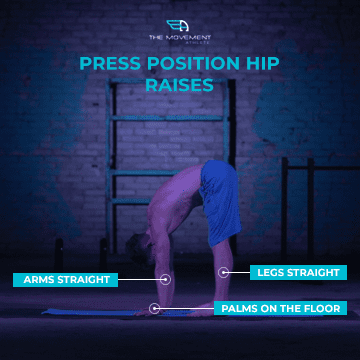![[Educational]_Hollow_Hold_Weighted_Arm_Raises How to workout duirng the corona virus](https://themovementathlete.com/wp-content/uploads/2019/12/Educational_Hollow_Hold_Weighted_Arm_Raises.png)
Join the tribe of Movement & Calisthenics Athletes – people just like you that are working with their own body weight to get strength, lose fat build muscle, recover from injuries and live their best lives!
Learning standing press to handstand is a great skill for handstand control. After acquiring a solid freestanding handstand, this could be the next skill to learn. Press to handstand is a challenging journey. To speed up the learning process, you must take the proper progressions.
Press position hip raises is one of the best exercises to teach the proper position to get into standing press to handstand. The exercise will teach you the proper body position and also strengthen the major muscles that you will be using for the press to handstand.
Unlike what most people think, press to handstand does not require an abysmal amount of strength, but it does need a good foundation of strength, mobility, and great technique. Press position hip raises helps in developing the first (and arguably the hardest) position in the press to handstand: the initial lift-off.
The press to handstand entry needs you to stack your hips over your shoulder and lean over further so you can lift off your feet from the ground. This exercise prepares you exactly for that motion.
Train your press position hip raises to further increase your handstand control and finally get the standing press to handstand.
👍HOW TO KNOW WHEN IT’S SAFE TO ATTEMPT?
You’ll need a good amount of wrist, arm and shoulder strength and mobility. To get a gauge if you’re ready for the exercise; if you already have a good proper form free-standing handstand, your upper body is ready for the exercise.
A strong core and scapula are also needed for the exercise. Train your hollow body hold and handstands then you are good to go.
Don’t forget about your lower body preparation. Good mobility and flexibility are also needed for the exercise. Demands will be put mostly on your hips and hamstrings. You need to be able to do at least a standing piked position that you can comfortably flatten your palms on the floor.
All of the above prerequisites might sound intimidating but all are pretty much still basic and very achievable in a relatively short amount of time. All you need is patience, dedication and a good program similar to The Movement Athlete Academy.
✅Summarized Benefits
- Teaches proper body position and entry for standing press to handstand.
- Strengthen your core, hip flexors, arms, wrists, and shoulders.
- Enhances lower body mobility.
- Promotes stronger freestanding handstand.
How to Perform💪
- Begin standing with feet a little wider than shoulder width.
- Keeping your legs straight, bend at the hips and place hands on the floor a few inches away from your feet.
- Keep legs straight, and begin to lean forward shifting weight onto your hands and coming up on your toes.
- Rock back shifting weight onto your feet, and lifting hands slightly off the floor.
- Repeat for specified repetitions.
👉Keep in mind
Proper body form
All positions should be strong and in proper form. You should already be comfortable in the piked position. You can do it actually in a straddle position or with legs together. Have a slight protraction in your scapula. Have your shoulders already fully elevated. Imagine pushing already hard against the ground. The head should be in a neutral position.
Keep this body position after you shifted your weight forward except for the head. Tuck your chin to your body so you can fully put your weight forward without putting too much strain on your neck.
The lift-off
Once you’ve shifted all your weight on your hands and wrists, you’ll automatically go in a tip-toe position, or even better, lift fully your feet off the ground. This is a natural response to the mechanics of your body. Don’t forcefully lift your feet off by jumping or thrusting your hips. Just lean forward enough so it will be a natural response.
Be careful because all of your weight will be put on your wrists and anterior shoulders. If you cannot fully support your weight yet in this position, you’ll hit your head straight to the ground.
Another response is that the lower part of your palms might come up. When this happens, keep pushing to the ground hard with your fingers and upper portion of your hand. You can also grip the ground with your fingers slightly crumpled instead of having them flat on the ground. This gives you better hand control and grip on the floor.
Don’t forget to breathe! Breathe in when you shift your weight forward then breathe out when you go back to the first position.
Coaching Pointers
Starting Position:
Bent hips
Straight legs
Straight arms
Neutral head position
Arms straight
Fingertips touching the floor
Scapula protraction
Shoulder elevation
Movement Position:
Most weight on hands
Some weight on toes (No weight if you can fully lift your feet off)
Chin tucked to the body
Straight arms
Straight legs
Palms come up
Even more bent hips
Finish Position:
Weight back fully on feet
Keep everything tight for the next repetition


